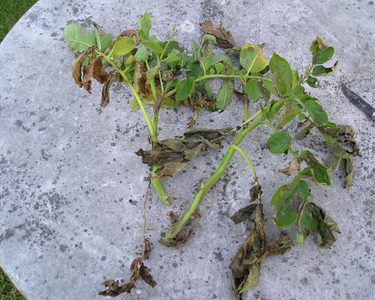Pests and diseases
Potato blight

What is potato blight?
There are two types of blight, early blight (Alternaria solani) and late blight (Phytopthora infestans). Late blight is the most common and most damaging. The term 'blight' is normally taken to mean 'late blight'.
How to spot late blight
Blight can strike from any time after June, and the incidence increases through the growing season. As it is airborne, it will infect the leaves first. You will notice it as distinct brown to grey lesions, about the size of a penny, close to the edges of leaves.
Blotches often have a yellowish halo - not to be confused with smaller brown dots which are more likely to be nutrient potassium or magnesium deficiency. The leaves quickly become weak and watery and rot.
Tubers infected with blight will have dark, sunken areas on the surface, which may cover the whole potato. Cutting the potato in half will show patches of chestnut-coloured rot starting just under the skin.
Other fungi and bacteria may follow, invading the tuber to produce a wet, foul smelling soft-rot. Seemingly health tubers may rot later when in store.
The disease is more likely to take hold if the weather is damp and still. Under these weather conditions, it is a good idea to look for signs of infection.
Treating potato blight
If you notice just a few infected leaves, remove them and dispose of them in your household rubbish. Don't put them on your compost head as most domestic heaps are not warm enough to kill off infected material.
If dry conditions follow, you may be lucky and the crop can be salvaged.
If the disease becomes widespread throughout the leaves it is best to remove all the tops at this stage as they will shed spores that wash down and infect the tubers, causing them to rot.
You can still harvest your tubers, but leave them in the ground for 2 weeks, as this will allow the skins to set, sealing them up from disease.
Steps to avoid getting potato blight
Harvest early
Blight pressure increases through the season, so the earlier you can harvest your potatoes, the less likely they are to succumb to the disease. The best way to ensure earlier harvests is to select earlier maturing varieties, like first earlies and early maincrops such as Maris Bard and Orla.
Chitting your seed (letting it sprout first) before planting will also help your crop advance more quickly.
Grow resistant varieties
The best way to avoid blight is to select varieties which have better resistance to it.
Many lists showing which varieties have good resistance are out of date, as new strains of the fungus evolve quite regularly. However, Sarpo varieties, originating from Hungary show remarkable resistance to the disease (see below).
Tidy up tubers
Blight will not survive in the soil on its own, but it will remain on diseased tubers left in the ground. These are the main source of infection for next year’s crops, as are dumped tubers in piles or on compost heaps.
Spacing and watering
Avoid planting in sheltered sites. If you need to water, apply it to the base of the plants, preferably early in the morning, to reduce long periods of moisture on the foliage. Digging in, or mulching with, organic matter will reduce the need for watering.
Ridging and mulching
Blight spores on foliage are washed down through the soil to infect tubers. Earthing-up potatoes, or mulching the soil with a thick layer of hay, straw or other organic material, can reduce the levels of tuber infection.
Sarpo varieties
These were developed at the Savari Trust (www.sarpo.co.uk) in order to minimise the chemical inputs that went into growing potatoes. The varieties show good blight resistance, compete vigorously against weeds, and can be stored for a long time without sprouting.
- Sarpo Axona: This red-skinned maincrop variety is suitable for baking, roasting, and mashing. Both the tubers and the leaves show very good resistance to blight.
- Blue Danube: An early maincrop variety that has striking purple tubers and is very good for roasting and mashing. Unlike most Sarpo varieties, the leaves do not show good resistance to blight, but the tubers are very resistant so won’t rot if the disease strikes.
- Sarpo Kifli Kifli: A waxy salad variety. It is an early maincrop, and both the leaves and the tubers show good resistance to blight.